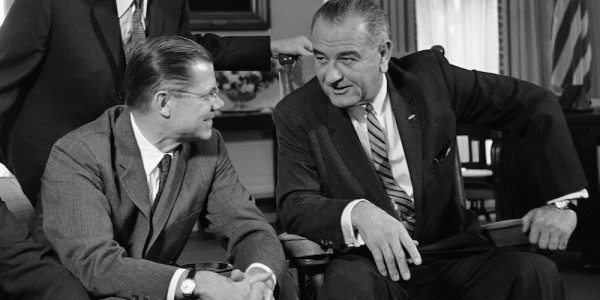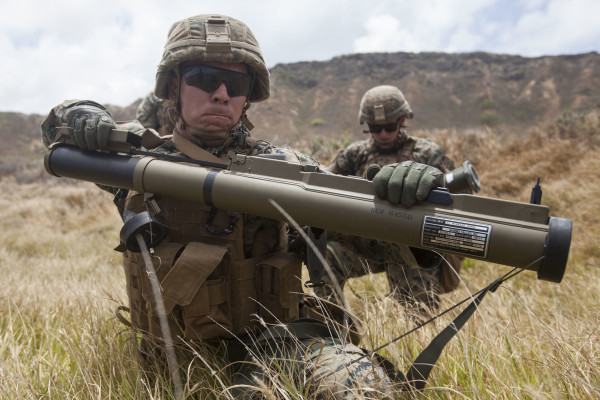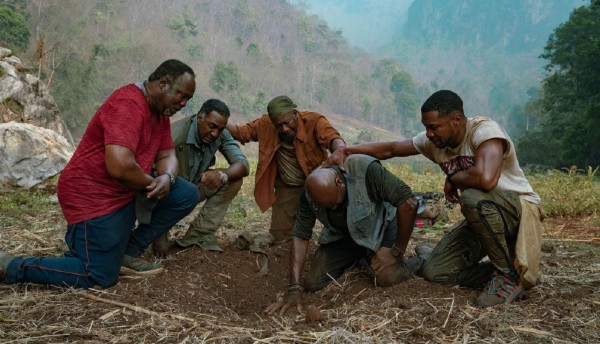In 1967, a young man named Johnny Gupton was drafted into the Army to fight in Vietnam. Gupton didn’t know how to read or write; he didn’t even know what state he was from. He had never heard of Vietnam. When a fellow soldier questioned a noncommissioned officer (NCO) about how someone with such an obvious mental disability could join the Army, the NCO responded, “Ehh, he’s one of McNamara’s Morons.”
This is what soldiers like Gupton were known as throughout the Armed Forces during the Vietnam War era. In 1967, Defense Secretary Robert McNamara lowered military recruiting standards as part of a program called Project 100,000. Its goal, as the name suggests, was to recruit 100,000 men each year who were otherwise mentally, physically or psychologically underqualified for service. These men all had IQs below 91, and nearly half had IQs below 71. From the Project’s launch in 1966, through its termination in 1971, it allowed 354,000 previously ineligible men into the military. Of these, 5,478 died in combat and 20,270 were wounded.
These men were aggressively recruited and pushed through training without having met even the bare minimum of standards set for them. They were sent into combat in large numbers and many died. They were promised greater benefits and opportunities as an incentive to join the military, but those who returned alive came home to broken promises and were abandoned by the government. It’s a largely forgotten and shameful chapter in American history.
Robert McNamara and the Johnson Administration sold Project 100,000 as an expansion of Great Society welfare programs where poor, mentally disabled men could learn important life skills. Labor Secretary Daniel Moynihan said, “Expectations of what can be done in America are receding. Our best hope is to use the Armed Forces as a socializing experience for the poor.”
This is how the idea was sold to the public, but there is a much more obvious reason to aggressively recruit mentally disabled soldiers. As the war raged on, more and more Americans were needed to fight in Vietnam each year. Children of the affluent middle class could avoid the draft by seeking an educational deferment (like Dick Cheney) or by finding a friendly doctor to get a medical deferment (like Donald Trump). McNamara and Johnson were faced with a choice; they could end draft deferments for college students and send children of the affluent to war in a country most Americans could not yet find on a map, or they could start signing up a lot more mentally disabled people. Guess which one they chose?

On October 1, 1966, McNamara officially launched Project 100,000. His plan targeted those with the least ability to avoid the draft. Their high levels of poverty and mental disabilities guaranteed they could not receive student deferments. Many National Guard units were still segregated during the Vietnam Era, which meant many Black men of conscription age could not enlist in their respective National Guard units to avoid being sent to Vietnam. In 1969, 42 percent of Mississippi’s population was Black. Yet of their 10,365 National Guardsmen, only one was Black. So with children of privilege safe in America, the military got to work recruiting from the ranks of the mentally disabled.
New Standards
To explain how New Standards men — this is what they officially were known as — were recruited, some more background information about the standards themselves will be necessary. Newly enlisted soldiers took the Armed Forces Qualification Test (AFQT) to determine their military aptitude. Tests were divided into five categories:
- Category I: Very high IQ (124 and above)
- Category II: Above average IQ (108-123)
- Category III: Average (92-107)
- Category IV: Below average (72-91)
- Category V: Very below average (71 or lower)
Category IV places someone in the bottom 10th percentile of the population, with Category V indicating a cognitive disability of some kind. Traditionally, only Categories I-III were considered fit for military duty. Special waivers were allowed for people in Category IV, and those that scored in the range of Category V were completely barred from enlistment.
Project 100,000 changed these standards. McNamara mandated that all Category IV scorers be allowed to enlist. Category V enlistees were technically barred, but 30,301 were enlisted through a loophole known as “administrative acceptance.” This was designed to prevent draftees from avoiding military service by intentionally failing the AFQT. Induction centers could pass Category V testers if they found they “possessed a higher mental level than implied by their test score.” This practice was used on would-be draft dodgers but was much more common for genuinely disabled people. Would-be draft dodgers who intentionally failed would be given the option to retake the test to avoid being administratively pushed through to a front-line infantry unit, which they almost always took. The only people who routinely got pushed through with Category V scores were people who could not test any better.
Many of these recruits could not read or write at all. So how did they take the tests?
They didn’t.
Recruiters took the tests for them. A Cleveland-based Marine recruiter testified before Congress that forging test results was common practice. Their test takers were so proficient at faking results that they could take the test and produce the exact test score requested of them. Recruiters were so desperate to meet quotas that they would sign the names and forge paperwork for Category V recruits who could not even write their own names.
Military recruiting specifically targeted poor areas — both urban and rural — and New Standards recruits were disproportionately Black. In a RAND Corporation study of New Standards recruits versus a control group of the military at large, 38 percent of these recruits were Black or Hispanic, compared to 10 percent of the control group. 13 percent read below a fourth-grade level versus one percent of the control group. They were over twice as likely to come from the South. These demographics were targeted by Project 100,000 for a reason.
McNamara pitched it as a welfare program, emphasizing the “special skills” New Standards recruits would receive. However, only 7.5 percent of them received any kind of remedial vocational training. 5.4 percent failed out of basic training entirely. The rest were mostly just passed along.

Basic training presented serious challenges to many of the New Standards recruits. Author Hamilton Gregory described his experience with mentally disabled soldiers at a remedial boot camp in his book McNamara’s Folly. He saw soldiers who struggled to negotiate an obstacle course because they were confused by the arrows which were meant to point them in the right direction.
While some New Standards recruits faced abuse, it was more common for them to be passed along and made to be someone else’s problem. Gregory described seeing drill instructors who forged academic and PT scores for their soldiers. More disturbingly, he observed another incident where drill instructors stole the wallets of their disabled soldiers.
During his time in remedial boot camp with New Standard recruits. Gregory repeatedly wrote members of Congress imploring them to hold hearings about the treatment of mentally disabled people in the military. The only congressman or senator who responded was Bobby Kennedy. When he was killed in June of 1968, any chance of an elected representative stopping Project 100,000 died with him.
Combat
Unlike forging a test result during basic training, performance in combat isn’t something that can be manipulated. At a certain point, there was nobody left to pass the New Standard soldiers off to. As a result 5,478 mentally disabled soldiers lost their lives. Project 100,000 soldiers saw combat at a rate nearly twice as high as other soldiers and were killed at a rate three times as high.
Project 100,000 soldiers weren’t just a danger to themselves, either. Having soldiers who could not understand even basic commands posed a danger to everyone in their vicinity. A popular infantry officer was killed by his own Project 100,000 soldier by accident. The soldier was supposed to let him into their patrol base after he gave the password, but the soldier got confused and shot his own platoon leader. Another mentally disabled recruit couldn’t figure out the safety of his M16. One day on patrol he negligently discharged his rifle and accidentally shot and killed another soldier.
A common complaint amongst the troops was that Project 100,000 soldiers gave up their position by making too much noise and talking too loudly. They exhibited little understanding of how to behave in combat. This is to be expected of soldiers who don’t know where they’re from or how to tie their shoelaces. One veteran described his experiences with them in combat, “they talked too loud and made too much noise while moving around, didn’t know what to take into the bush or even how to wear it properly, couldn’t respond to basic combat commands, fired too much ammo, and tended to flake out on even the easiest 10-klick [kilometer] moves.”
Of the 5,478 New Standards soldiers who died in combat, over 1,500 were confirmed to have died from triggering mines and booby traps. Many died because they were too slow to perceive they were triggering a booby trap, but many others because they were given the dangerous job of walking in front of formations to sweep for mines. As one infantry squad leader said, “if anybody has to die, better a dummy than the rest of us.”
The mentally disabled men sent to combat by Robert McNamara cannot be blamed for their shortcomings. Most of them lacked the mental capacity to serve in combat roles. They were cannon fodder, chosen as human sacrifices to ensure combat roles were filled by people lowest on the totem pole. In return for their sacrifices, they were supposed to receive training that would lift them out of poverty and allow them to improve their lives upon returning from Vietnam. Would it surprise you to learn this was all a lie?
Returning Home
New Standards soldiers returned home to circumstances worse than when they’d joined the military. Many were traumatized from combat and suffered from post-traumatic stress disoder. Others were adversely affected by the cruel and abusive treatment they received from fellow service members while in the military.
A 1991 study compared the outcomes of Project 100,000 veterans against a comparable group of “low-aptitude” non-veterans. The average income for non-veterans was $23,637 compared to $17,629 for veterans. Non-veterans also had lower unemployment rates, lower divorce rates, and higher educational attainment on average than Project 100,000 veterans.
One factor explaining their more precarious situation is that 180,000 of them were given other-than-honorable discharges from the military. Jed Sluder, who had an IQ of 68, received an other-than-honorable discharge from the Navy. His mental disabilities made him a frequent target of bullying. His shipmates would strip him naked and rub him with grease in the boiler room. This harassment caused him to frequently go AWOL, which led to his other-than-honorable discharge. He was unable to find work after his service due to this blemish on his record. Sluder was doomed to a life of misery.
1st Lt. Barry Romo was serving as a Platoon Leader in Vietnam when he found out his nephew Robert was in basic training at Fort Lewis. He believed it had to be a mistake. Barry knew Robert was autistic and had failed the AFQT, so he wrote the base commander at Fort Lewis asking him to remove Robert from training, warning him Robert would certainly die in combat if he was sent. His request was denied.
Robert was eventually sent to a frontline infantry unit. He was shot in the neck on a patrol. The bullet went through the side of his neck, causing him to bleed slowly, while his fellow soldiers refused to treat him. Robert died slowly, drowning in his own blood while grasping at his neck. His hands weren’t the only ones covered in blood.
+++
Buchanan Waller is an Army Reservist, law student, and writer. He lives in Minneapolis with his wife and dog.
The latest on Task & Purpose
- The Navy’s top enlisted sailor tried to lift the spirits of a beleaguered crew. He didn’t
- What this old Russian tank tells us about the invasion of Ukraine
- Navy’s top enlisted sailor tells crew dealing with string of deaths that his answers won’t ‘make you real happy’
- The Air Force is trusting the internet to name its ridiculous new cybersecurity mascot
- A military housing company kept committing fraud after pleading guilty to fraud, Senate report finds
Want to write for Task & Purpose? Click here. Or check out the latest stories on our homepage.























